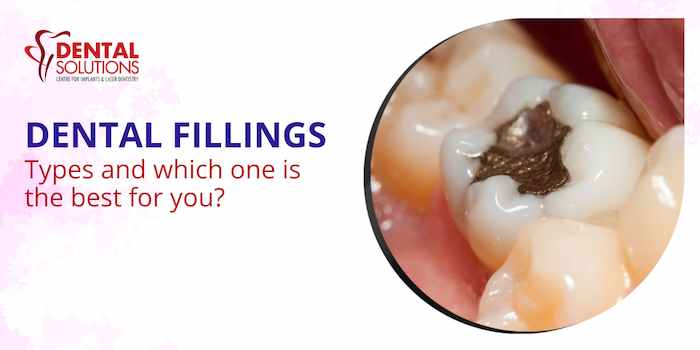- +917892951808
- Indiranagar, Bangalore
Best Dental Clinic In Bangalore Indiranagar | Best Dentist in Bangalore Indiranagar
- Home
- About Us
- Treatments
- Blog
- Contact Us
5 Types of Dental fillings, Which one is the best?

Types of Dental fillings: A trip to a dental clinic isn't an exciting one. Especially if you've been experiencing signs of cavities. But, visiting the dentist is important and not an option, in fact, it is the only option to be considered when experiencing cavities. Early diagnosis can not only help prevent cavities but avoid your oral health condition from getting worse.
To treat the cavity, the dentist will remove the decayed part of the tooth and fill the hollow space with Dental Fillings. The cavity can be filled either by the traditional technique of drilling or by the latest contactless laser cavity filling
There has been confusion that dental fillings are only used to fix cavities. That is incorrect, dental fillings are not only used for treating cavities, but also used to repair broken or cracked teeth, or teeth that have been worn down.
What are the different types of dental fillings ?
There are different types of dental fillings available today. The dentist will inform you on which one would best suit your condition. Sometimes, you may have the option to choose, but you may not always have a choice and would need to go with the one that is advised by the dentist.
Before you go for the treatment, it is best to know about the different types of dental fillings.
Here are 5 different types of dental fillings you should know about:
- Silver Amalgam Fillings
- Composite fillings
- Glass ionomer fillings
- Gold fillings
- Ceramic
- Silver Amalgam Dental Fillings
Although the name has “Silver” In it, it is made out of a mixture of different metals, such as mercury, tin, copper, and silver. Half of the mixture is made up of mercury, while the other substances make up the rest. This is the most common and widely used dental filling because it's durable, strong and cost effective.
Silver Amalgam fillings are known to last for 10 years or more, if they are taken well care of. They have proven to be strong and can withstand all chewing forces for long years. Also, there are usually no concerns of the filling being contaminated by blood or saliva.
However, there are a lot of disadvantages – Some have found this filling to be aesthetically unappealing, as it does not match the tooth colour. Over the years, it can cause teeth discoloration since amalgam fillings are silver fillings that can get darker overtime. To add to this, Amalgam fillings are also known to cause sensitive teeth. There is no scientific evidence, however certain research suggests that this could be due to the reaction of metal to varying temperatures in the mouth.
Finally, a major concern is that this filling can weaken the teeth. Wondering how? Well, while preparing the tooth a portion of the tissue of the tooth has to be removed in order to install these fillings, which can cause the remaining teeth to weaken.
This type of filling is not a very popular filling when it comes to dental advice, yes, dentists now-a-days would mostly not recommend these fillings as the disadvantages weigh heavier than the advantages.
2. Composite Dental Fillings
Composite fillings are made of silica, plastic, glass quartz and/or other ceramic particles which are added to a resin base. The filling is bonded into the hollow space (after the cavity is removed and the tooth is prepared) and then hardened with a bright blue curing light. The dentist will try to prepare the filling to match your teeth shade, although over the years, staining can change the colour.
This too is a popular choice of filling, mostly because it matches the colour of the tooth and in this type of filling, when removing the decay and preparing for the filling, less tooth structure needs to be removed compared to amalgam fillings.
At the same time, you need to know that composite fillings don't last as long as the other types. They need to be replaced every five to 7 years. They are also more expensive compared to silver amalgam and are not as strong amalgam.
3. Glass Ionomer Dental Fillings
Glass ionomer dental fillings are made of a specific type of glass material and acrylic. This type of filling is mostly used in young children as the teeth are still undergoing change. What makes Glass ionomers unique from the other types of tooth fillings is, it releases fluoride, which helps protect the tooth from further decay.
Glass ionomers are significantly weaker compared to composite resin filling. They tend to wear and tear easily, are more prone to tooth fractures and also have a life span that is less than 5 years. They also do not match the tooth colour as precisely as composite fillings. However, when it comes to the cost of Glass ionomers dental filling, they are almost the same as composite fillings.
4. Gold Dental Fillings
These are long-lasting and durable fillings that will last for years. Gold fillings are composed of an alloy of gold and other metals, including copper. However, these fillings are the most expensive of all the fillings and hence, are not a very popular option.
An advantage of gold is that it does not corrode or tarnish and has great strength which prevents further decay and damage to the tooth. This kind of filling usually requires more than one dental visit, as after the impression has been taken, the filling needs to be prepared in the laboratory accordingly. While the filling is being prepared, a temporary filling is placed in the cavity.
The only downside of this type of dental filling is the cost, the cost can go up to 7 times more than silver amalgam!
5. Ceramic Dental Fillings
Ceramic dental fillings are usually made of porcelain. Porcelain is hard and long lasting, and just like silver amalgam, gold fillings, this too lasts for long. It can also be coloured to match your tooth colour shade.
These fillings do not stain easily, have high resistance to abrasion. These dental fillings also need more than one visit and can be quite expensive.
Compared to the other types of dental fillings, the procedure is slightly different for this one, as the empty space needs to be enlarged further to create room for the filling's bulkiness.
Taking care of your Dental Fillings
We have mentioned the life-span of the different types of dental fillings, but to make sure they last that long, you need to follow good oral hygiene — regular dental visits for cleanings, brushing with fluoride toothpaste, flossing, using an antibacterial mouthwash and avoiding consumption of carbonated or sugary drinks.
If you notice a piece of the filling is missing or there is a crack in the filling, inform your dentist and pursue further treatment.
If you are experiencing signs of cavities, do not neglect them. Reach out to us for more information on how cavities can be treated and if left untreated, how they can wreak havoc in your mouth. Our dental team will advise you on what kind of filling material is suited based on your situation.
